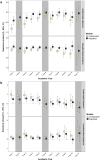Birth weight and school absences and attainment: a longitudinal linked cohort study of compulsory schooling in England
- PMID: 40280730
- PMCID: PMC12171418
- DOI: 10.1136/archdischild-2025-328611
Birth weight and school absences and attainment: a longitudinal linked cohort study of compulsory schooling in England
Abstract
Objective: To explore how birth weight and size-for-gestation may contribute to school absences and educational attainment and whether there are different associations across sex and income groups.
Design: Longitudinal linked cohort study.
Methods: Data were drawn from the Millennium Cohort Study, a nationally representative cohort of children born in 2000-2001; percentage of authorised and unauthorised absences from Year 1 to Year 11, and Key Stage test scores at ages 7, 11 and 16 in English and Maths were linked from the National Pupil Database. Birth outcomes and covariates were derived from the 9-month survey, and linear regressions with complex survey weights were fitted.
Results: Being born small-for-gestational-age (vs average-for-gestational-age) was associated with an increase of 0.47%, 0.55% and 0.40% in authorised absences in Years 1, 3 and 4 (n=6659) and with a reduction of 0.16-0.26 SD in all English and Maths test scores (n=6204). Similar associations were found for birth weight. After adjusting for prior test scores, English (b=0.07) and Maths (b=0.05) performance at age 11 remained associated with birth weight. Socioeconomic status modified the associations: there were larger disparities in test scores among higher-income families, suggesting that higher income did not compensate for being born small-for-gestational-age.
Conclusion: Children born smaller missed slightly more classes (~1 day per year) during primary school and had lower English and Maths performance across compulsory education. Exploring specific health conditions and understanding how education and health systems can work together to support children may help to reduce the burden.
Keywords: Child Health; Epidemiology; Infant Development.
© Author(s) (or their employer(s)) 2025. Re-use permitted under CC BY. Published by BMJ Group.
Conflict of interest statement
Competing interests: None declared.
Figures



Similar articles
-
Maternal Serum Iodine Concentrations in Early Pregnancy Exhibited Well Diagnostic Ability for Thyroid Dysfunction, Inverse Associations with Gestational Weight Gain, and Birth Size: Longitudinal Analyses Based on Huizhou Mother-Infant Cohort.Biol Trace Elem Res. 2025 Jul;203(7):3618-3629. doi: 10.1007/s12011-024-04443-7. Epub 2024 Nov 29. Biol Trace Elem Res. 2025. PMID: 39609361
-
Surveillance for Violent Deaths - National Violent Death Reporting System, 50 States, the District of Columbia, and Puerto Rico, 2022.MMWR Surveill Summ. 2025 Jun 12;74(5):1-42. doi: 10.15585/mmwr.ss7405a1. MMWR Surveill Summ. 2025. PMID: 40493548 Free PMC article.
-
Prevalence and odds of anxiety and depression in cutaneous malignant melanoma: a proportional meta-analysis and regression.Br J Dermatol. 2024 Jun 20;191(1):24-35. doi: 10.1093/bjd/ljae011. Br J Dermatol. 2024. PMID: 38197404
-
Sudden Unexpected Infant Death Rates and Social Determinants of Health Among Hispanic Infants.JAMA Netw Open. 2025 Jun 2;8(6):e2515986. doi: 10.1001/jamanetworkopen.2025.15986. JAMA Netw Open. 2025. PMID: 40522659 Free PMC article.
-
Defining disease severity in atopic dermatitis and psoriasis for the application to biomarker research: an interdisciplinary perspective.Br J Dermatol. 2024 Jun 20;191(1):14-23. doi: 10.1093/bjd/ljae080. Br J Dermatol. 2024. PMID: 38419411 Free PMC article. Review.
References
-
- Office for National Statistics Birth characteristics in england and wales: 2019. 2019
MeSH terms
LinkOut - more resources
Full Text Sources
Medical
